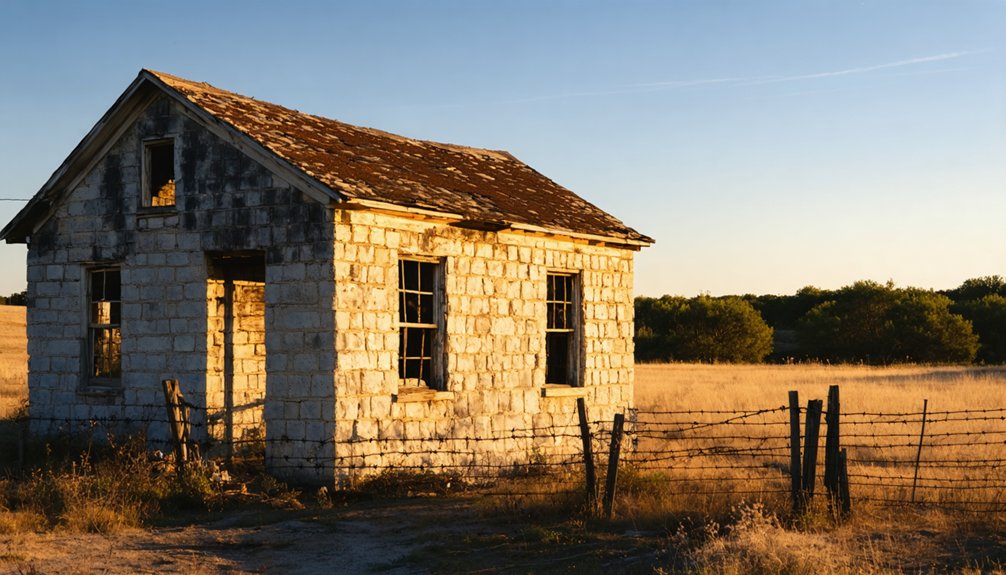You’ll find Pedernales nestled along its namesake river in Texas Hill Country, where German immigrants built a vibrant settlement in the 1840s. Led by Wilhelm Victor Keidel, the community thrived on cotton farming, with homesteads spanning 160 acres and a bustling schoolhouse serving as its heart. After World War II, declining enrollment and population shifts transformed this once-flourishing town into a ghost town, though its preserved schoolhouse and cemeteries still whisper stories of pioneer life.
Key Takeaways
- Originally settled by German immigrants in the 1840s along the Pedernales River, led by Wilhelm Victor Keidel as first physician and chief justice.
- The community thrived with cotton farming, two general stores, and a German-language school serving up to twenty students until 1945.
- Indian raids, drought, and economic challenges caused many original German settlers to abandon their homesteads by the 1890s.
- The settlement’s final decline occurred after World War II when the local school merged with Wrede School District in 1949.
- Today, Pedernales exists as a ghost town with preserved architectural remnants, including the schoolhouse converted into a private residence.
The German Settlement Origins
While German immigrants began flooding into Texas during the 1830s, the settlement of Pedernales emerged as part of a larger migration wave that transformed the Texas Hill Country.
You’ll find that the Adelsverein, a society dedicated to protecting German immigrants, played a vital role in bringing over 7,000 settlers to the region. The organization established key communities like New Braunfels and Fredericksburg as launching points for further German immigration and cultural integration. Just like in Fredericksburg, settlers in Pedernales received ten-acre farming lots to establish themselves.
In the late 1840s, Pedernales took shape when notable German settlers, including artists Karl Friedrich Hermann Lungkwitz and Friedrich Richard Petri, made their home there. The fun-loving Lutherans and Catholics became the predominant religious groups in the Pedernales valley.
The settlement followed the pattern of other German communities in the area, where settlers received town lots and farming parcels, quickly establishing the foundations of a self-sustaining community.
Life Along the Pedernales River
If you’d visited the early Pedernales settlement in the 1870s, you’d have found families living along the river’s rich grasslands and savannah, where they built homes and cultivated crops near reliable water sources.
You’d have seen cattle grazing on tall native grasses between scattered tree clumps, while farmers worked the fertile soil made possible by the river’s complex groundwater system.
Your journey through the river valley would have revealed a vibrant community life centered around the waterway, where German settlers adapted their agricultural practices to the limestone-rich landscape while drawing sustenance from the Pedernales’s steady flow. The area’s sedimentary rock types – including limestone, sandstone, and shale – created unique challenges and opportunities for early farming communities. Ancient bald cypress trees lined the riverbanks, providing shade and natural landmarks for the settlers.
River Settlement Early Days
As German immigrants arrived in the late 1840s, they established a vibrant settlement along the Pedernales River under the leadership of Wilhelm Victor Keidel, Gillespie County’s first physician and chief justice.
You’ll find that these pioneering settlers chose their location wisely, as the river’s abundant resources provided fresh water for drinking, household use, and basic irrigation in the rugged hill country.
The river valleys attracted settlers with their fertile soil and natural shelter, while the Spanish-named Pedernales River offered flint deposits that Native Americans had long used for tools. The area required careful disambiguation of locations since multiple settlements shared the Pedernales name across Texas.
You’ll appreciate how the watershed’s network of creeks and springs sustained the growing community, which soon included notable artists Hermann Lungkwitz and Friedrich Richard Petri. The settlement’s growth continued into the 1850s when two stores became central gathering places for the community.
Agricultural Life Near Water
On typical 160-acre homesteads, you’d have seen a diverse mix of agricultural activities.
Cotton dominated the landscape, with local gins processing up to 1,500 bales in good years.
The introduction of the first cotton gin in 1870 revolutionized local farming operations.
Farmers balanced crop diversity with livestock operations, letting cattle and sheep graze on rich grasslands while tending their fields.
They built lasting stone walls and fences that defined their plots, marking their independence on this productive frontier land.
The area’s transformation began when early settlers arrived in the 1870s, establishing farms and ranches across the region.
Community Along River Banks
Life along the Pedernales River banks fostered a rich cultural tapestry in the late 1840s, where German immigrants joined Anglo-Saxon Protestants from Tennessee and Alabama to forge new communities.
You’ll find evidence of vibrant riverbank activities throughout the settlement’s history, from the bustling cotton gins and stores that dotted the landscape to the artistic pursuits of photographers and landscape painters.
Community interactions centered around Wilhelm Victor Keidel’s free medical services and the local school, which served as a hub until 1945. The settlement, positioned seven miles southwest of Fredericksburg, drew strength from the river’s resources, including the flint stones that gave Pedernales its name.
While drought and economic hardship eventually led to decline, the river’s banks tell stories of indigenous peoples, German settlers, and American pioneers alike.
Community Growth in the 1860s
During the 1860s, Pedernales and its surrounding region experienced significant demographic shifts amid the turbulent backdrop of the Civil War. Settlement patterns reflected the diverse mix of Southern whites, African American slaves, Tejanos, and German immigrants who called this frontier land home. The Treue der Union monument honors those who lost their lives during this tumultuous period.
Agricultural practices centered on Indian corn and wheat cultivation, with settlers gradually expanding their improved farmland. Captain James Callahan led some of the earliest settlers to the region in 1854.
The impact of war and frontier challenges brought dramatic changes:
- You’d have witnessed the county’s divided stance on secession, voting 170 to 86 against it.
- You’d have seen brave settlers facing increased Indian raids after Federal troops withdrew.
- You’d have felt the economic strain as farm values plummeted from $576,302 to $90,736.
- You’d have noticed the loss of over 16,000 sheep, devastating local ranching operations.
Agricultural Legacy and Economic Activities
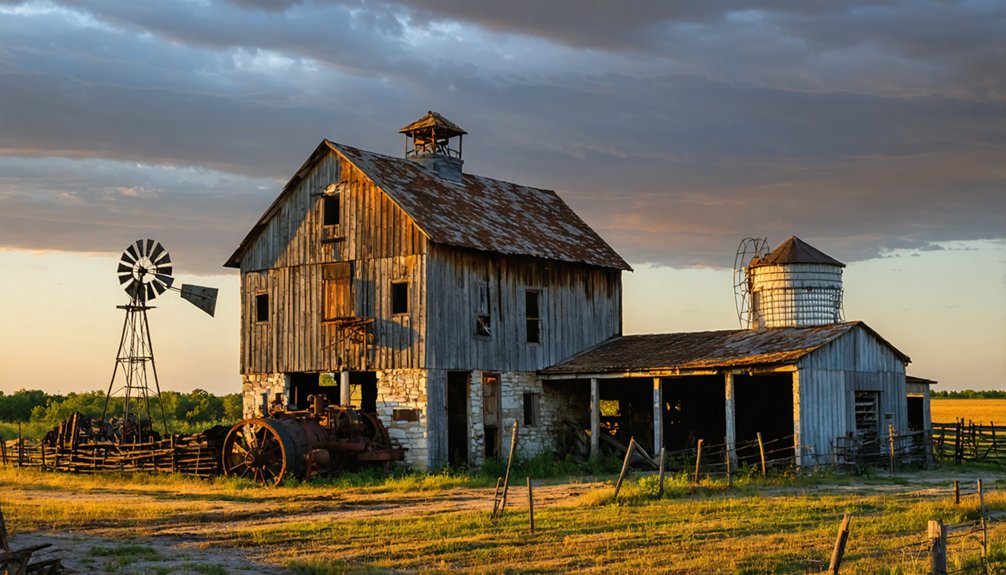
Building upon its early settlement patterns, Pedernales emerged as a thriving agricultural center in the late 1800s.
You’ll find evidence of agricultural innovation in the rapid expansion from 176 farms to 519 between 1870 and 1880, with improved land soaring from 3,690 to over 35,000 acres. The introduction of cotton gins spurred economic sustainability, while Indian corn and wheat remained staple crops.
However, nature’s harsh reality struck in the mid-1880s when severe drought forced many settlers to abandon their dreams.
The community’s resilience showed as they shifted from intensive farming to grazing practices. While the agricultural boom didn’t last, its legacy lives on in Pedernales Falls State Park, where you can still spot remnants of early farming infrastructure, including the historic rock houses and Trammell’s Crossing.
The Rise and Fall of Local Education
You’ll discover the earliest roots of Pedernales education in the 1850s when local children attended classes alongside those from Live Oak district.
By the late 1860s, the community established its own German-language school that served up to twenty students and doubled as a Methodist church under Greene Wilson’s ministry.
The school’s steady operation continued until 1945, when consolidation with the Wrede district marked the end of Pedernales’ independent educational era.
School’s Early Growth Period
As German settlers established roots in Pedernales, the community’s commitment to education took shape with the 1854 formation of the local school district.
The early curriculum reflected both academic necessities and cultural heritage, with instruction likely delivered in German during the initial years.
The limestone schoolhouse became a symbol of the community’s educational values, serving multiple purposes beyond basic instruction.
You’ll find these defining characteristics of Pedernales’ educational growth:
- Single teachers managed seven grade levels, demonstrating remarkable dedication
- Annual “schulpruefung” exams united families in celebration of learning
- Methodist services shared the space, making it a true community center
- Peak enrollment reached twenty students in the late 1870s, marking the height of local education
Consolidation With Wrede District
The post-World War II era brought considerable changes to Pedernales’ educational landscape when declining enrollment numbers forced the local school to merge with the Wrede School District in 1949. This consolidation impact extended beyond mere administrative changes, as it represented a shift in how rural Texas communities approached education.
You’ll find that the merger proved beneficial for both schools, with Wrede’s enrollment peaking at fifty-three students in the 1950s under the guidance of two teachers.
Teacher salaries at Wrede jumped considerably, from $28 monthly in 1896 to $288 by 1959, reflecting improved educational resources.
While the consolidation meant less local control, it provided students with better opportunities and helped maintain educational stability during a time of rural population decline.
Daily Life in Early Pedernales
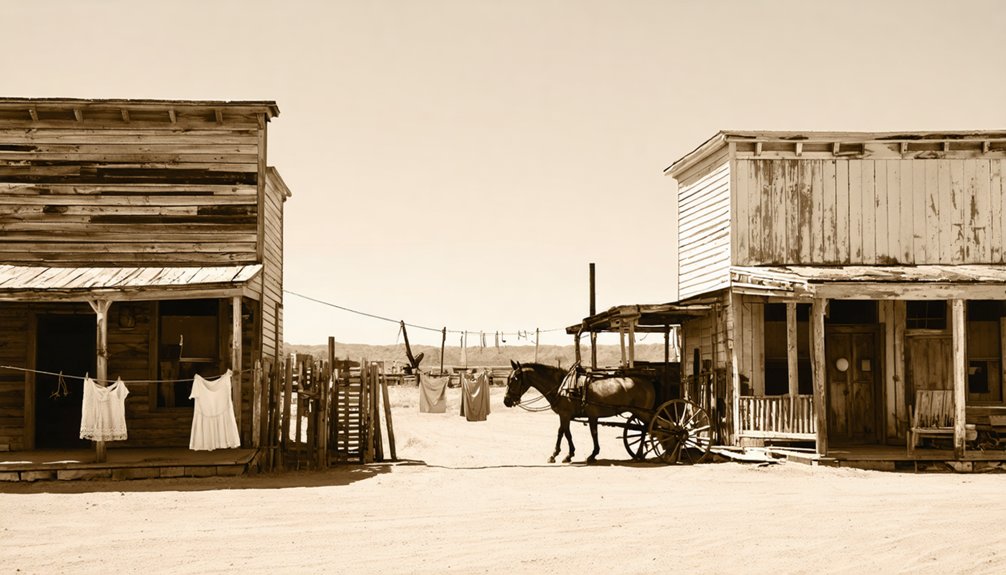
Life in early Pedernales revolved around the demanding rhythms of farming and ranching, with German immigrants and settler families like the Wilsons, Trammels, and Rainses establishing their homesteads in the 1840s and 1870s.
These pioneering spirits built rock houses, enclosed fields, and adapted to the challenging Texas Hill Country environment.
You’d find settler traditions reflected in their daily activities:
- Rising before dawn to tend livestock and maintain the enclosed crop fields
- Trading at the general store, a hub of early commerce and community life
- Sending children to the local school, which served as a cornerstone of community identity
- Maintaining vigilant watch for Indian raids while working the land
Despite harsh conditions and security concerns, the tight-knit community persevered, though overgrazing eventually stripped the fertile topsoil, fundamentally changing their agricultural practices.
Transformation Through the Decades
You’ll find the transformation of Pedernales marked by a steady exodus of its original German settlers through the late 1800s, driven by Indian raids, drought, and changing economic conditions.
By the 1890s, many early homesteads stood abandoned as families sold their land to larger landowners like the Trammells, fundamentally altering the community’s small-farm character.
The final chapter of Pedernales as a living settlement came in 1945 when its schoolhouse closed, later becoming a private residence and leaving the once-vibrant community to fade into ghost town status.
From Settlers to Silence
Founded in the late 1840s by German immigrants, Pedernales emerged as a promising settlement under Wilhelm Victor Keidel’s leadership, drawing notable residents like artists Hermann Lungkwitz and Friedrich Richard Petri.
The transformation from thriving community to ghost town unfolded through these pivotal changes:
- Native American conflicts in 1869-1870 disrupted the settlement’s growth, though successful defense efforts preserved the community’s foothold.
- The 1870s brought economic hope with cotton farming, preserving cultural heritage through agricultural innovation.
- Harsh droughts of the 1890s forced many original families to abandon their dreams, erasing community memories.
- By 1900, large landowners had consolidated the remaining properties, marking the final transformation from vibrant settlement to silent landscape.
Today, only a historical marker stands where these pioneering spirits once built their lives.
Schoolhouse Becomes Private Home
While the settlement itself faded into history, one resilient structure stood the test of time – the Pedernales schoolhouse.
You’ll find this native limestone building transformed from its original 19th-century educational role into a private residence during the early 1980s. The schoolhouse’s rich history as a community anchor, where German-Texan children studied under a single teacher and families gathered for events, lives on through its preserved exterior architecture.
Today, as you drive along State Highway 16 near the Pedernales River, you’ll spot this lone survivor of a vanished era.
While it’s no longer accessible to the public, the converted schoolhouse stands as a symbol of the area’s heritage, remaining the only tangible link to this ghost town’s pioneering past.
Architectural Remnants and Preservation
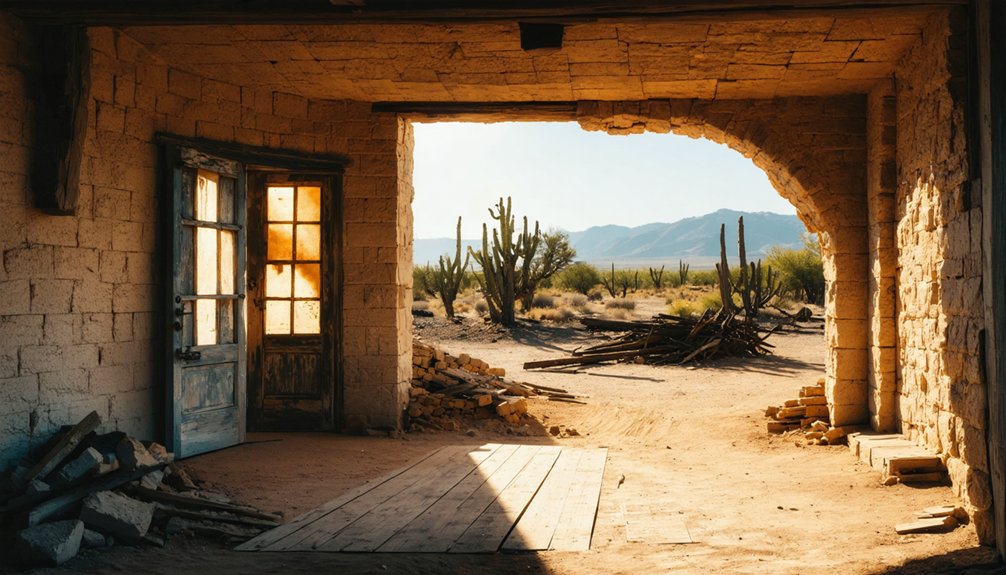
Architectural remnants in Pedernales offer glimpses into the town’s German immigrant heritage and early 20th-century craftsmanship. You’ll find evidence of European influence in staircases, masonry work, and the overall community layout.
The architectural significance is most visible in the preserved schoolhouse, now serving as a private residence since the 1980s.
Despite preservation challenges, you can still discover:
- Skilled brick masonry displaying Polish, Italian, British, and Irish craftsmanship
- Historic cemeteries with period-specific wrought iron fencing and headstones
- Western-style storefronts with wooden bracing fighting decay
- Distinctive industrial fencing featuring customized barbed wire designs
Without formal historic district designation or consistent funding, these remnants face ongoing threats from isolation, environmental wear, and disuse.
Yet they stand as evidence of the independent spirit of early Texas settlers.
Environmental Challenges and Land Use
As urban development encroaches on the Pedernales River Basin, this historic ghost town faces mounting environmental pressures that threaten its ecological heritage.
You’ll find the once-pristine watershed challenged by increased wastewater discharge, with 20,000 gallons per day of treated effluent threatening local groundwater and surface water quality.
Land management issues have intensified across the 800,000-acre basin, as property fragmentation disrupts wildlife corridors and alters natural water flows.
Fragmentation of the vast basin disrupts vital ecosystems, threatening wildlife movement and natural water patterns across the landscape.
You’re witnessing the impacts of expanding impervious surfaces, which increase stormwater runoff and sedimentation in the river.
While conservation easements work to protect critical areas, environmental sustainability remains precarious.
The river’s ecological character, crucial to both wildlife and recreation, depends on your community’s commitment to preserving these historic waters from urban sprawl and pollution.
The Legacy of a Lost Community
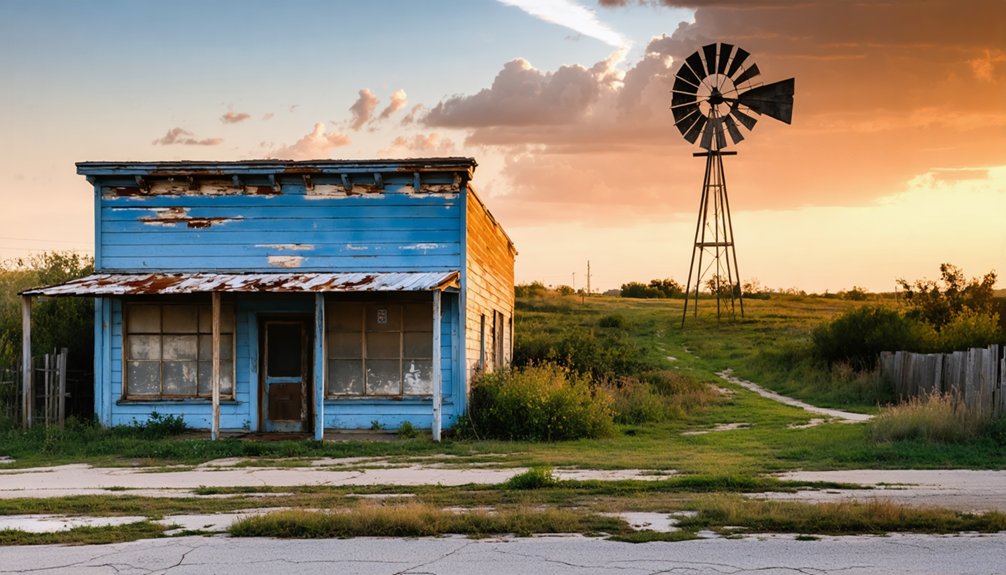
Beyond the environmental challenges facing the Pedernales River Basin lies a rich historical tapestry of German settlement and pioneer spirit.
As you explore this ghost town’s legacy, you’ll discover compelling historical narratives that shape our understanding of Texas Hill Country’s development.
The cultural interactions and pioneer experiences of Pedernales live on through:
- John J. L’s extensive documentation of local families and settlement patterns from 1850 to 1970
- Surviving pioneer structures, including rock houses and walls that stand as evidence of early settler ingenuity
- Oral histories preserving accounts of Native American encounters and German-Texan immigration
- The old schoolhouse, now a private residence, serving as a physical reminder of the community’s educational heritage
These elements collectively tell the story of a once-thriving settlement that shaped the region’s cultural landscape.
Frequently Asked Questions
What Native American Tribes Originally Inhabited the Pedernales Area Before German Settlement?
You’d find Native tribes like the Lipan Apaches and Tonkawas settled there first around the 14th century, while Kiowas and Comanches arrived later, drawn by Spanish horses, enriching the cultural heritage.
How Did Residents Celebrate Holidays and Maintain German Cultural Traditions?
You’ll find residents celebrated through German holiday traditions like communal feasts, folk singing, and Lutheran services, while cultural festivals featured traditional dancing, costumes, and shared dishes from their homeland.
Were There Any Notable Conflicts Between Pedernales Settlers and Neighboring Communities?
Playing it cool, you’ll find settler disputes weren’t common in Pedernales. While they faced Native American raids, community relations between German settlers and neighboring towns remained largely peaceful through the 1800s.
What Happened to the Cemetery and Burial Records of Early Settlers?
You’ll find most early settler graves at Pedernales Falls Cemetery remain unmarked, with no formal burial documentation preserved. Cemetery preservation efforts are minimal, and the site’s remote location limits accessibility.
Did Any Famous Historical Figures Ever Visit or Stay in Pedernales?
As you explore the windswept ruins and rustic remnants, you’ll find no documented evidence of famous visitors or notable historical figures staying in this remote settlement during its brief period of historical significance.
References
- https://tpwd.texas.gov/publications/pwdpubs/media/pwd_bk_p4507_0026m.pdf
- https://roadtripsoul.com/pedernales-falls-history/
- https://texascooppower.com/south-texas-lost-ghost-town-of-linnville/
- https://www.tshaonline.org/handbook/entries/pedernales-tx
- https://en.wikipedia.org/wiki/List_of_ghost_towns_in_Texas
- https://www.texasescapes.com/MichaelBarr/Pedernales-Texas.htm
- https://www.texasescapes.com/TOWNS/Texas-Ghost-Towns-3-Hill-Country.htm
- https://texaswanderers.com/category/historic/ghost-towns-history/
- https://migrantknowledge.org/2024/04/04/on-to-texas-an-introduction-to-the-miniseries-on-texas-germans/
- https://www.fbgtx.org/208/History
